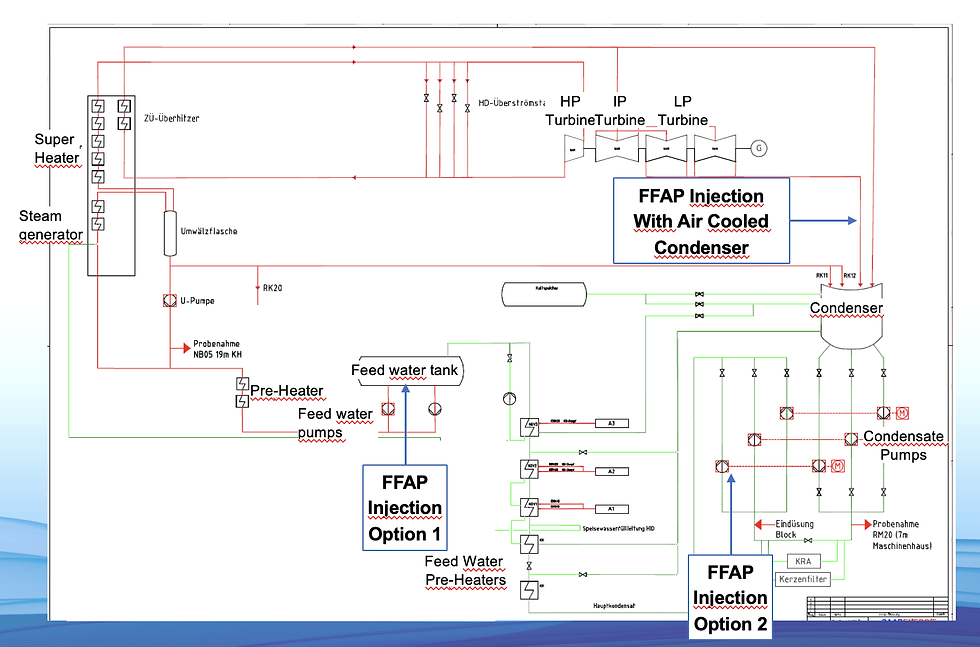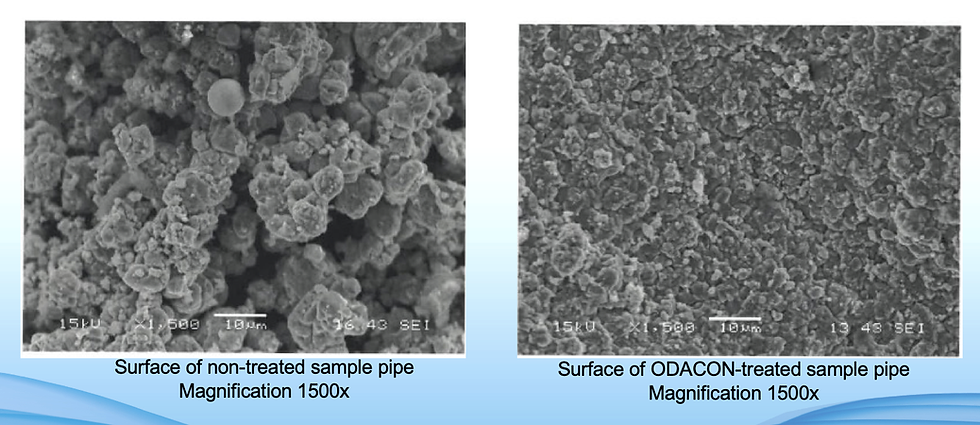Mastering Film-Forming Amines: Preservation Procedures
- Björn Otto

- May 19
- 4 min read
Abstract
Ensuring long-term protection of water and steam systems during offline periods remains a challenge in industrial operations. Traditional methods such as nitrogen blanketing and dry preservation often fall short in terms of efficiency and practicality. Film-forming amines (FFAs) present a modern solution for preservation, offering immediate corrosion protection during shutdown and lay-up periods. This article explores the implementation of FFAs for preservation, focusing on dosing strategies, application timing, and long-term stability. Practical case studies from fossil and biomass plants illustrate the effectiveness of FFAs in maintaining system integrity during extended offline phases.
Introduction The preservation of water and steam systems during offline periods is a critical aspect of power plant operation. Corrosion can begin almost immediately after a shutdown, particularly in vulnerable areas such as turbine blades, condensers, and steam lines. Traditional methods such as nitrogen blanketing or air drying require significant time and logistical effort, often proving ineffective for short-term shutdowns or unplanned outages. In contrast, film-forming amines provide immediate protection by forming a hydrophobic barrier on metal surfaces, stabilizing chemistry without the need for extensive mechanical interventions.
This article examines the use of FFAs for preservation applications, covering their unique properties, dosing strategies, application points, and best practices for ensuring long-term corrosion protection. Supported by case studies from fossil and biomass plants, it highlights the real-world effectiveness of FFAs in reducing corrosion product transport and extending system lifespan during offline periods.
The Need for Advanced Preservation Techniques When a plant is shut down, oxygen ingress and stagnant conditions rapidly accelerate corrosion. Even a slight delay in nitrogen blanketing or system drainage can initiate pitting and surface degradation. In steam turbines, blade surfaces are particularly vulnerable, where water film formation leads to localized corrosion points that act as starting zones for cracking upon restart. Condenser tubes and preheaters also experience accelerated material loss if not preserved correctly.
Film-forming amines address these vulnerabilities by coating exposed surfaces with a hydrophobic layer that resists moisture and oxygen penetration. Their volatility allows them to distribute uniformly across steam and water pathways, reaching areas typically missed by conventional preservation methods. Furthermore, FFAs provide a seamless transition from operation to preservation without the need for extensive shutdown procedures, making them ideal for flexible operation scenarios.

Dosing Strategies and Application Timing
Effective preservation with FFAs begins during the final days of normal operation. By gradually increasing FFA concentration in the feedwater and condensate systems, a protective film is established before shutdown. This ensures that corrosion is mitigated from the moment the system goes offline. Typically, target concentrations of 2 ppm are recommended for full surface coverage.
Operators can adjust concentration based on available shutdown time. For planned outages, a steady increase over 5 to 10 days is optimal, while unplanned or rapid shutdowns may require more concentrated dosing to achieve the same level of protection. In such cases, operators may temporarily bypass condensate polishing units to prevent resin fouling and ensure effective film formation.
Film-forming amines also prove effective in situations where partial drainage is necessary. Due to their chemical properties, the protective film remains intact even in partially drained systems, extending the lifespan of components that remain exposed to air or residual water. This capability allows for significant flexibility in preservation planning and reduces the need for extensive dry-down procedures.
Injection Points and System Coverage
The placement of injection points significantly impacts the distribution and effectiveness of FFAs during preservation. In most installations, injection into the feedwater tank or deaerator ensures thorough mixing and pre-heating of the solution before it enters the main circuit. For systems with air-cooled condensers (ACC), direct injection into the steam line prior to the ACC maximizes coverage on large carbon steel surfaces that are particularly prone to corrosion during offline periods.
For plants with complex configurations, a dual-injection strategy may be employed to guarantee coverage across both the water and steam phases. This method ensures that all critical areas, including preheaters, steam turbines, and economizers, receive adequate protection during standstill.
Long-Term Stability and Reactivation
One of the key advantages of FFAs in preservation is their long-term stability. Unlike conventional methods that require regular reapplication or monitoring, the hydrophobic film created by FFAs remains effective as long as mechanical damage or thermal stress does not disrupt it. This stability reduces the need for periodic maintenance and monitoring, providing cost savings and operational efficiency.
Moreover, FFAs can be reactivated upon startup without the need for extensive reapplication. As the system transitions back to operation, the amine layer continues to provide corrosion protection, preventing the rapid mobilization of iron and other corrosion products typically observed during recommissioning.

Case Studies: Proven Effectiveness in Preservation
Fossil Power Plant (Germany)
A 2200-ton-per-hour coal-fired plant in Germany faced challenges with corrosion during standby periods. Traditional preservation methods were insufficient to prevent iron transport and pitting. After switching to an FFA-based preservation strategy, corrosion levels dropped significantly, with iron transport reduced by 70% during startup. Visual inspections confirmed the formation of a uniform, smooth magnetite layer that provided enhanced protection.
Biomass Plant (Sweden)
A peak-load biomass facility in Sweden faced difficulties preserving its feedwater and turbine systems during seasonal shutdowns. By implementing an FFA preservation protocol, the plant achieved full hydrophobic coverage even in partially drained systems. After two years of seasonal operation, endoscopic inspections revealed clean, corrosion-free surfaces with stable magnetite formation, proving the long-term reliability of FFA application.

Conclusion
Film-forming amines have redefined preservation procedures in water and steam systems. Their ability to provide instant, reliable protection during offline periods minimizes corrosion risks and extends the life of critical components. Unlike traditional methods, FFAs enable smooth transitions between operation and standstill without complex draining or nitrogen blanketing. With proper dosing strategies and system-specific application points, FFAs offer a modern, efficient solution for long-term system preservation.
Author Bio
Ronny Wagner is the Managing Director at REICON Wärmetechnik und Wasserchemie Leipzig GmbH. As an experienced water treatment professional, he specializes in the application of film-forming amines in water-steam cycles, as well as in closed cooling and heating systems. With over 15 years of experience in the preservation of nuclear, fossil, and industrial power plants, he has played a pivotal role in advancing industry best practices. As an active member of vgbe and the IAPWS Power Cycle Chemistry (PCC) group, he has co-authored several international standards for the safe and effective application of film-forming amines in power plant chemistry.


